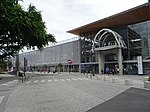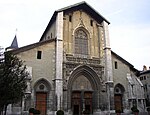Chambéry

Chambéry (UK: , US: , French: [ʃɑ̃beʁi]; Arpitan: Chambèri) is the prefecture and largest city of the Savoie department in the Auvergne-Rhône-Alpes region of southeastern France. The population of the commune of Chambéry was 59,172 as of 2020, while the population of the Chambéry metropolitan area was 255,790. The city is located at the foot of the French Alps between Bauges and Chartreuse mountains, making Chambéry an important railway and highway crossroads. It has been the historical capital of the Savoy region since the 13th century, when Amadeus V, Count of Savoy, made the city his seat of power. The annexation of Savoy merged the city to France in 1860. Together with other alpine towns Chambéry engages in the Alpine Town of the Year Association for the implementation of the Alpine Convention to achieve sustainable development in the Alpine Arc. Chambéry was awarded Alpine Town of the Year 2006.
Excerpt from the Wikipedia article Chambéry (License: CC BY-SA 3.0, Authors, Images).Chambéry
Rue du Bon Pasteur, Chambéry
Geographical coordinates (GPS) Address Nearby Places Show on map
Geographical coordinates (GPS)
| Latitude | Longitude |
|---|---|
| N 45.57 ° | E 5.9118 ° |
Address
Rue du Bon Pasteur 290
73000 Chambéry
Auvergne-Rhône-Alpes, France
Open on Google Maps







